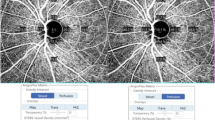Abstract
The exact cause of primary open angle glaucoma is still unknown. Intraocular pressure is a major factor but it is impossible to explain the whole mechanism of glaucomatous optic nerve damage with only increased intraocular pressure. Other factors play important roles in the development of glaucoma. With this point of view, vascular factors have been implicated in the pathogenesis of glaucoma.
We tried to determine the etiopathogenetic role of decreased erythhrocyte deformability in normal tension glaucoma and high-tension glaucoma. The study group consisted of 16 patients with the diagnosis of normal tension glaucoma, 17 patients with the diagnosis of high-tension glaucoma, and 24 patients as controls.
Independent t-tests were used to compare the three groups two by two for age, hematocrit, mean cell volume, plasma protein level, cardiovascular risk factors, and erythrocyte deformability. There was no statistically significant relationship (p > 0.05) between the groups concerning the erythrocyte deformability. When we consider all of 57 patients, we found that both increasing age (> 60 years) and greater mean cell volume (> 84 fl) had a statistically significant relationship with decreased erythrocyte deformability (p < 0.05). When we performed Pearson correlation analysis, we found that only mean cell volume and erythrocyte deformability had a statistically significant relationship (r=0.31, p=0.02).
We conclude that decreased erythrocyte deformability is not a major factor in the ethiopathogenesis of normal tension glaucoma and high-tension glaucoma.
Similar content being viewed by others
References
Drance SM. Bowman Lecture. Glaucoma - changing concepts. Eye 1992; 6: 337-342.
Haefliger IO. The vascular endothelium as a regulator of the ocular circulation: A new concept in opthalmology? Survey of Ophthalmology 1994; 39: 123-132.
Guyton Arthur C. Textbook of Medical Physiology 1986: 208-209.
Nash GB. Blood rheology and ischemia. Eye 1990; 5: 151-158.
Puniyani RR. Haemorheological profile in cases of chronic infections. Clin Hemorheol 1988; 8: 595-602.
Reid HL. Impaired red cell deformability in peripheral vascular disease. Lancet 1976; 1: 666-667.
Sakai T. Red cell deformability in patients with cerebral vasospasm. Int J Clin Pharmacol Ther Toxicol 1985; 23(2): 79-82.
Sternitzky R. Hemorheologic studies for evaluating microcirculation in patients with peripheral arterial circulatory disorders and diabetes mellitus. Z Gesamte Inn Med 1986; 41(19): 539-542.
Flammer J. Vascular concept of glaucoma. Survey of Ophthalmology 1994; 38(suppl): S3-S6.
Schwartz B. Circulatory defects of the optic disc and retina in ocular hypertension and high pressure open-angle glaucoma. Survey of Ophthalmology 1994; 38(suppl.): S23-S34.
Fraunfelder FT. Drug induced ocular site effects. Williams and Wilkens 1996: 421-427, 451-457.
Koutsouris D. Individual red blood cell transit time during flow through cylindirical micropore. Clin Hemorheol 1988; 8: 453.
Fisher TC. Pulse shape analysis of red blood cell micropore flow via new software for the Cell Transit Analyser. Biorheology 1992; 29: 185-201.
Hayreh SS. Inter-individual variation in blood supply of the optic nerve head. Its importance in various ischemic disorders of the optic nerve head and glaucoma, low tension glaucoma and allied disorders. Doc Ophthalmol 1985; 59: 217-246.
Hamard P. Blood flow rate in the microvasculature of the optic nerve head in primary open angle glaucoma. A new approach. Surv Ophthalmol Supplement May 1994; 38: S87-S94.
Chien S. Shear dependence of effective cell volume as a determinant of blood viscosity. Science 1970; 168: 977-979.
Schmid-Schonbein. Microrheology of erythrocytes, blood visocity, and the distribution of blood flow in the microcirculation. In: Guyton AC, Cowley AW (eds) ‘International review of physiology’. University Park Press, Baltimore, pp 1-61, 1976.
Baskurt OK. Deformability of red blood cells from different species studied by resistive pulse shape analysis technique. Biorheology 1996; 33(2): 169-179.
Klaver JHJ. Blood and plasma viscosity measurements in patients with glaucoma. Br J Ophthalmol 1985; 69: 765-770.
Trope GE. Blood viscosity in primary open-angle glaucoma. Can J Ophthalmol 1987; 22: 202-204.
Wolf S. Retinal hemodynamics using scanning laser ophthalmoscopy and hemorheology in chronic open angle glaucoma. Ophthalmology 1993; 100: 1561-1566.
Carter CJ. Investigations into a vascular etiology for low tension glaucoma. Ophthalmology 1990; 97: 49-55.
Foulds WS. 50th Bowman Lecture. ‘Blood is thicker than water’. Some hemorheological aspects of ocular disease. Eye 1987; 1: 343-363.
Mary A. Erythrocyte deformability measurements in patients with glaucoma. J Glaucoma 1993; 2: 155-157.
Leonhardt H. Vollblut-und Plasmaviskositat bei koronaren Risikofaktoren. Klin Wochenschr 1977; 55: 481-486.
Paterson A. The lens. In: Hart WM (ed) ‘Adler’s physiology of the eye’. Mosby Year Book, St. Louis, pp 348-390, 1992.
Watanabe H. Alterations of human erythrocyte membrane fluidity by oxygen-derived free radicals and calcium. Free Radic Biol Med 1990; 9: 507-514.
Mary A. Erythrocyte deformability in an in vitromodel of hypoxia/reoxygenation-protective effects of superoxide dismutase and catalase. Clin Hemorheol 1992; 12: 287-296.
Hirayama T. Effect of oxygen free radicals on rabbit and human erythrocytes. Scand J Thorac Cardiovasc Surg 1986; 20: 247.
Powell RJ. Oxygen free radicals: Effect on red cell deformability in sepsis. Crit Care Med 1991; 19(5): 732-735.
Wiek J. Haemorheological parameters in patients with retinal artery occlusion and anterior ischemic optic neuropathy. Br J Ophthalmol 1992; 76: 142-145.
Weinreb RN. Blood rheology and glaucoma (editorial). J Glaucoma 1993; 2: 153-154.
Author information
Authors and Affiliations
Rights and permissions
About this article
Cite this article
Ates, H., Uretmen, O., Temiz, A. et al. Erythrocyte deformability in high-tension and normal tension glaucoma. Int Ophthalmol 22, 7–12 (1998). https://doi.org/10.1023/A:1006004206304
Issue Date:
DOI: https://doi.org/10.1023/A:1006004206304




